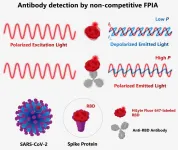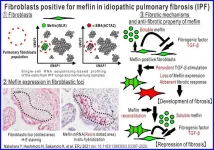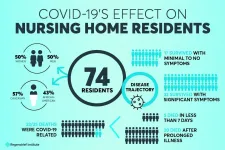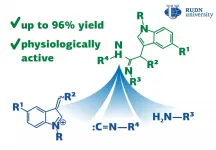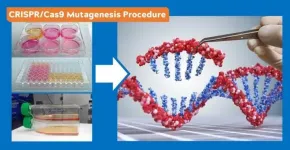(Press-News.org) New research will help doctors identify, treat and prevent potentially dangerous irregular heartbeats in patients with hypertrophic cardiomyopathy (HCM), a common heart condition in which the heart thickens and strains to pump blood.
These chaotic heart rhythms are known as atrial fibrillation. Atrial fibrillation can be asymptomatic, but it can lead to blood clots, stroke or even heart failure. The new research, from an international team of doctors and scientists, identifies risk factors for major atrial fibrillation outcomes, such as the need for procedures or hospitalization for more than 24 hours, in patients with hypertrophic cardiomyopathy.
Age was the dominant predictor, the researchers found. But they also identified a list of other predictors, including obesity as measured by body mass index (BMI). Obesity was particularly important in younger patients, the researchers conclude.
"The latter finding points out the importance of weight loss and exercise in HCM patients," said researcher Christopher Kramer, MD, the chief of the Division of Cardiovascular Medicine at UVA Health, Virginia's only designated Center of Excellence by the Hypertrophic Cardiomyopathy Association. "Until only recently, exercise was thought to be contraindicated in HCM. This is no longer the case based on recent studies."
Atrial Fibrillation in Hypertrophic Cardiomyopathy
Like atrial fibrillation, hypertrophic cardiomyopathy often goes undiagnosed. It is, however, the most common inheritable heart disease, and it is the most common cause of sudden cardiac death in young athletes.
Atrial fibrillation is a common complication among patients with hypertrophic cardiomyopathy. Previous studies have focused on detecting atrial fibrillation, as patients may require blood thinners to prevent stroke. But Kramer and his colleagues wanted to look at atrial fibrillation outcomes to better identify those who need early or tailored interventions.
The researchers examined data from 2,631 patients, identifying 127 major end- points, such as needing hospitalization or catheter ablation, in 96 of the patients. Key risk factors for reaching an endpoint included age; BMI; size and function of the heart's left atrium; moderate or severe failure of the heart's mitral valve to close completely; and history of arrhythmia (irregular heartbeat).
Obesity was a stronger risk factor in younger patients than older ones. The remaining risk factors were greater risk factors for middle-aged and older patients.
The researchers say their findings can be used to create a risk-assessment tool for patients, to identify those at risk and help keep them out of the hospital.
"These findings will help physicians who treat HCM patients, as they can target the risk factors that lead to atrial fibrillation," Kramer said.
INFORMATION:
Findings Published
The researchers have published their findings in the scientific journal JACC: Clinical Electrophysiology. The research team consisted of Kramer, John P. DiMarco, Paul Kolm, Carolyn Y. Ho, Milind Y. Desai, Raymond Y. Kwong, Sarahfaye F. Dolman, Nancy Geller, Dong-Yun Kim, Martin S. Maron, Evan Appelbaum, Michael Jerosch-Herold, Matthias G. Friedrich, Jeanette Schulz-Menger, Stefan K. Piechnik, Masliza Mahmod, Daniel Jacoby, James White, Amedeo Chiribiri, Adam Helms, Lubna Choudhury, Michelle Michels, William Bradlow, Michael Salerno, Dana K. Dawson, Jonathan W. Weinsaft, Colin Berry, Sherif F. Nagueh, Chiara Buccarelli-Ducci, Barbara Casadei, Hugh Watkins, William S. Weintraub and Stefan Neubauer.
The research was supported by the National Institutes of Health; the National Heart, Lung and Blood Institute (grant U01HL117006-01A1); and the Oxford NIHR Biomedical Research Centre. Kramer has received research funding from BMS and Cytokinetics and has been consultant for BMS and Cytokinetics. A full list of the authors' disclosures is included in the paper.
To keep up with the latest medical research news from UVA, subscribe to the Making of Medicine blog at http://makingofmedicine.virginia.edu.
Scientists have developed a rapid, highly accurate test to detect antibodies against the spike protein of SARS-CoV-2 in human serum, opening a new avenue for understanding the full extent of the pandemic and evaluating the effectiveness of vaccines.
In the 18 months since the emergence of Covid-19 pandemic, great strides have been made in discovering and inventing various approaches to track and control the spread of the SARS-CoV-2 virus. Rapid and accurate diagnosis has always been vital in this regard. The gold standard since the beginning of the pandemic has been the RT-PCR method; however, it is time-consuming, labor-intensive, and requires sophisticated ...
Single-cell RNA sequencing has revealed a subset of cells that could provide protection from a rare, but severely debilitating and fatal, lung disease. The findings were published by Nagoya University researchers and colleagues in the European Respiratory Journal. Further research could lead to new therapeutic strategies for the disease, called idiopathic pulmonary fibrosis (IPF).
Approximately 15 in every 100,000 people worldwide develop IPF. Its prognosis and five-year survival rate can be worse than many types of cancer. It involves the development of scar tissue on the lung, impairing gas exchange and making ...
Austin, Texas (July 15, 2021)
Access to high-quality public transportation can make communities more equitable by increasing access to critical opportunities such as employment, health care and healthy food, particularly for low-income individuals and people of color. A END ...
INDIANAPOLIS -- Nursing homes throughout the United States have been devastated by the COVID-19 pandemic with many perceptions and misperceptions but little documentation about what has happened on a day-by -day basis to residents in these facilities. A study from Regenstrief Institute and Indiana University School of Medicine research scientists is one of the first to describe and identify patterns in the course of COVID-19 in the typically frail individuals who reside in nursing homes.
Much has been written about number of deaths, vaccine uptake and ...
Bone density, skin and hair health, and the mobility of joints depend to a great extent on the microelement of silicon. We mostly get it with food, but silicon is also consumed with some biologically active additives that promise beauty, longevity, and youth. The element can also be found in drinking water of a natural origin: usually, it is included in the compound of sodium salt and metasiliconic acid. However, in the case of microelements, one should be extremely careful: a deficiency could lead to diseases, but an overdose could bring negative effects too.
Together with colleagues from the Chuvash State University and the Hamburg Medical University, scientists of Immanuel Kant Baltic Federal University studied the effect of prolonged silicon consumption in relatively ...
To date, there are no effective antidotes against most virus infections. An interdisciplinary research team at the Technical University of Munich (TUM) has now developed a new approach: they engulf and neutralize viruses with nano-capsules tailored from genetic material using the DNA origami method. The strategy has already been tested against hepatitis and adeno-associated viruses in cell cultures. It may also prove successful against corona viruses.
There are antibiotics against dangerous bacteria, but few antidotes to treat acute viral infections. Some infections can be prevented by vaccination but developing new vaccines is a long and laborious process.
Now an interdisciplinary research team from the Technical University of Munich, the Helmholtz Zentrum München and ...
A new study finds that resilience is a dynamic process, rather than a fixed trait - and suggests this may have significant ramifications for the business world.
"Organizations are interested in cultivating a resilient workforce, because they want people who are able to remain committed to an organization and its goals over time," says Patrick Flynn, corresponding author of the study and an assistant professor of human resources management at North Carolina State University's Poole College of Management.
"Our work here does a couple things," Flynn says. "First it finds that resilience is more of a process than a characteristic. Second, it identifies some of the ...
RUDN University chemists obtained a metal-containing complex with an unusual planar architecture. The unexpected structure was formed due to the spontaneous fixation of carbon dioxide from the air during the reaction. This compound exhibits unusual magnetic properties (spin glass behaviour). This can be useful for creating memory storage devices. The results are published in the Journal of Organometallic Chemistry
Coordination polymers are hybrid crystalline coordination compounds contained of infinitely repeating fragments (structural elements). These structural ...
The mitochondrion has garnered quite the reputation for its role as the "powerhouse of the cell." These tiny, but mighty organelles play various life-sustaining roles, from powering our own cells and organs to fueling chemical and biological processes. But when they aren't working properly, a number of rare diseases can occur.
Mitochondrial diseases are a group of debilitating genetic disorders that affect one in 5,000 people throughout the world, most of them being children. Along with these diseases come a variety of health concerns including, but not limited to, heart ...
The pandemic has taught us that almost all companies have to sell on the internet. Bots are a technology that facilitates e-commerce. They are digital assistants that can answer customer queries about products that are sold or help to locate them, as well as supporting customers in the purchasing process. "In whatever language; and moreover, chatbots never get tired: They're available 24 hours a day, 365 days a year", said Jordi Cabot, the Universitat Oberta de Catalunya (UOC) researcher who created Xatkit, a company specialized in their development. This technology has existed for some time in big companies and is now also helping improve the digital competitiveness ...

